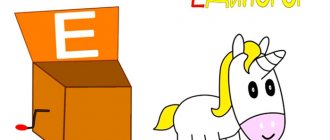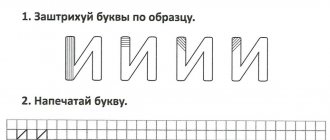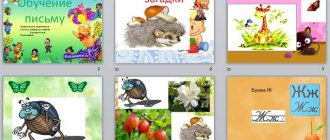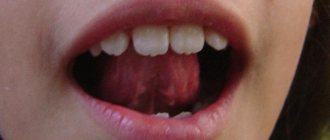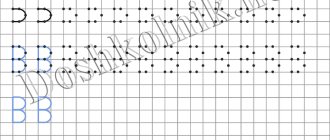How to check your child's pronunciation?
It often happens that the first to point out problems with a baby’s sound pronunciation are caregivers, teachers, or people who hear the baby speak for the first time. It is sometimes difficult for parents to notice the peculiarities of their child’s speech, since as a result of constant communication, we get used to the way the baby speaks. There are two ways to notice difficulties in pronouncing the sound “Ш” at home:
- Observation. This diagnostic option requires quite a long time and increased attention from adults.
- Exercises. Using various tasks (with gradually increasing difficulty levels), you can check how your child pronounces the sound “Ш”.
- Snake. Ask your baby to sound out the hissing sound of the snake (“sh-sh-sh-sh-sh”).
- “Repeat the syllables.” Start with combinations of two letters (“sha”, “shi”, “shu”, “ish”, “osh” and so on), then use combinations of three letters (“u-shu”, “a-sha”, “ e-she", "o-sho" and others). The most difficult combinations are with consonants (for example, “kshi”, “shka”, “shki”, “sshi”, “pshi”).
Pronounce all sounds clearly and with pronounced articulation. Children often pick up incorrect pronunciation from adults, so parents need to closely monitor the purity of their own speech.
- “Say the word.” For this exercise, you need to prepare cards in advance with images of objects known to the little ones, the names of which contain the sound you need. Examples of words: neck, hat, mouse, car, lily of the valley, cone, fur coat, galoshes, cat, rustles, rough, ball and so on.
- Phrases and sentences with the sounds “Ш”. This is the highest level of difficulty, since in order to pronounce sentences correctly, you need good articulation. Examples: “the cat is running after the mouse”, “Sasha was walking along the highway”, “a rough bump”, “Mom sewed me panties”, “Dasha put on a warm scarf”, “Misha splashes through the puddles”.
Sample tasks on the topic of sibilant consonants
A teacher who will conduct a lesson for first-graders on this topic should set himself the following tasks:
- he is obliged to create conditions for children to learn the concept of hardness and softness of consonants, for example, that “zh” and “w” are always hard;
- teach students to correctly formulate writing skills;
- develop their written and coherent oral speech;
- use new information technologies when teaching.
After the teacher explains the essence of the lesson, he can write several letters on the board (B, L, CH, K, R).
Then the question is asked which of the letters presented does not denote any sound, and the correct answer is b. You can also ask students to find the letter for the hissing sound.
Next, we suggest working with a textbook of the following nature:
- children are asked to take turns reading the text (the skill of reading aloud is improved);
- we select some words and invite the children to explain their meaning (at the teacher’s choice);
- offer to find those words that contain letters denoting hissing consonants;
- Have them say them out loud and write the letters on the board.
The next part of the lesson is to work with images . Hang pictures on the board and ask students questions:
- what objects are shown in the pictures;
- what names contain hissing sounds;
- Which of the listed sizzlers are hard and which are soft.
Options for incorrect pronunciation of the sound “SH”
Ideally, the sound “Ш” should be pronounced clearly and quite loudly (despite the fact that it is a voiceless consonant). Preschool children can change this sound in different ways in their speech. Speech therapists identify the following possible deviations:
- Interdental pronunciation. If the baby pushes his tongue forward too much, a lisp is heard in his speech (the sound “Sh” sounds like “F”).
- Nasal pronunciation (“Sh” turns into “X”) occurs when the root of the tongue rises to the hard palate and air passes through the gap between them.
- Whistling pronunciation (replacing “Sh” with “S”).
- The soft pronunciation (“Sh'” instead of “Sh”) occurs because the tongue is pressed against the lower front teeth.
- If the tongue rests on the upper incisors, a “T” sound is produced.
- Air flow may pass between the cheek and molars, resulting in a popping or squelching sound. The child accurately pronounces the sound “Ш” incorrectly if at this moment his cheeks swell.
Sometimes babies can pronounce the sound “Sh” quite clearly if their articulation organs are in the wrong position. Therefore, it is necessary to monitor exactly how the child produces sound.
Tongue twisters for the sound |dʒ|
- J oyful j oggers j og j oyously. J ames, J ohn, J enny and J ohnny are j oggers.
- The g enerous g ymnasts like oran g e j uice. The oran g e j uice makes the g ymnasts g enuinely happy.
- Can you ima gine an ima g inary mena g erie mana g er ima g ining mana g ing an ima g inary mena g erie?
As a musical example (besides the already mentioned “All That Jazz”), Ray Charles’ song “Georgia On My Mind”.
What prevents a child from “hissing”?
There are two groups of reasons why babies fail to pronounce the sound “Ш” correctly. Physiological reasons include:
- Insufficient development and immobility of the articulatory apparatus;
- Malocclusion (often caused by prolonged use of a pacifier);
- Short frenulum of the tongue;
- High palate;
- Oral diseases;
- Difficulties in phonemic perception (the child does not distinguish some sounds by ear);
- Hearing impairment;
The second group of factors are the mistakes of adults who are around the child.
- “Lisping” from adults;
- Incorrect pronunciation by adults (children always repeat after us).
Tongue twisters with the sound |tʃ|
- Cherry tea ch es ch ildren at ch ur ch . Ch erry also checks the rooms and does ch ores.
- The tea ch er changed the ques t ion in the ch Allenge. The ch Allengers changed the answers for the ques t ion.
- Charles is a ch eerful ch icken farmer. A poa ch er is wat ch ing Ch arles' ch ickens ch oosing whi ch to snat ch , and ch uckles at the ch ance of a ch oice ch icken to ch ew for his lun ch . But the ch uckle rea ch es Ch arles who ch ases the poa ch er and cat ch es him.
As a song example, the classic “We Are The Champions” by Queen.
From 0:38 to 1:17
Correct articulation for the sound "Ш"
In order for the sound to be pronounced clearly, it is necessary to explain and show the baby how the tongue should be positioned and how to fold the lips correctly.
- The lips should be slightly pushed forward and rounded (in the shape of a tube);
- The teeth are close together or completely clenched;
- The tip of the tongue must be raised to the anterior edge of the hard palate so that there is a gap between them;
- The lateral edges of the tongue should be pressed against the upper molars (air should not escape on the sides);
- There is a warm air stream in the middle of the tongue (you can feel it by bringing your hand to your mouth);
- The soft palate is raised and blocks the passage into the nasal cavity;
- Vocal cords are open (no voice).
Determining exactly how a child’s articulatory apparatus works when pronouncing a particular sound is not so easy. If you do not feel confident in yourself, be sure to seek advice from a speech therapist.
Classification of sounds in Russian
The phonetics of the Russian language includes vowels and consonants, indicated in writing by certain letters.
key vowel sounds that are under stress:
- A;
- U;
- ABOUT;
- E;
- Y;
- AND.
Since there are more consonant sound formations in the Russian language, they are classified according to the following criteria:
- method of education;
- place;
- according to the degree of participation of noise and voice.
If we talk about the ratio of noise and voice during the formation of consonants , then the classification looks like this:
- sonorants and their soft pairs (p, m, l) and “th” without a pair;
- noisy (voiced and unvoiced);
- hissing (sch, h, sh and zh).
In this case, Zh and Sh are always hard, and Ch and Shch are only soft.
How to teach a preschooler to pronounce the sound “SH”?
Classes with your baby should consist of successive stages (warm-up, breathing exercises, articulation exercises, production and automation of sounds).
- Warm up. Let your child become familiar with the organs that are necessary for speech. Sit with your baby in front of the mirror and look at the lips, tongue, cheeks, and palate. To prepare the articulatory apparatus for work, do a warm-up: run your tongue across the palate, lips, teeth, stick out your tongue, smile.
- Breathing exercises. We pronounce the sound “SH” as we exhale, and in order for it to sound clear, we need to control the amount of air exhaled. Simple exercises such as blowing out a candle or blowing soap bubbles, playing with a pinwheel, whistles, and so on will help with this.
- Speech, or articulation, gymnastics promotes the development of speech organs. Your baby will definitely enjoy these fun exercises and will help him learn to pronounce the sound “Ш”.
- "Cup". The lower jaw is in a relaxed position. A wide, flat tongue is placed on the lower lip, the tip and edges of the tongue are raised, forming a flat cup.
- "Horse". The task is to imitate the clatter of hooves (repeat for 15 seconds).
- "Paints". We move our tongue across the palate, as if painting it.
- "Swing". The tip of the tongue alternately touches the upper and lower teeth.
- "Watch." We move our tongue left and right, imitating the movements of a clock pendulum.
- "Jam". We lick our lower lip with our tongue.
You can see the correct execution of some articulation exercises for the sound “Ш” in the video:
To make it more interesting for your child, alternate the exercises performed and use colorful visual materials.
- Sound production and automation. This is a gradual process: first the sound is fixed in syllables, then in words, phrases and sentences. Sound production can be done in two ways: by imitation (when the baby repeats the correct articulation after an adult) and mechanically (this work can be done by a speech therapist using a probe). Parents can use some exercises to make the sound “Ш” at home. For example, “Clap your hands.” The child should clap the moment he hears the sound “Ш” in the word. This game develops phonemic awareness and promotes sound production. In order for the sound to become part of the child’s active speech and become automated, you can repeat small phrases and learn short poems that contain words with the corresponding sound. A variety of games are also suitable:
- “Call me kindly.” Invite your child to form a diminutive form of the word (hat - cap, cat - kitty, hare - hare, and so on).
- “Correct the mistake.” The child must understand what the semantic error is in the phrase and pronounce it correctly (for example, “Chess is playing Grisha,” “The cat is afraid of the mouse,” “Dasha put the hat on,” and so on).
Study Materials
Poetry
* * * What do we have in the forest starting with the letter Sh? This cone flopped, rustling. A bumblebee and a hornet are noisily rummaging through the porridge. Insects rustle in the rose hips. What else in the forest begins with the letter Sh? Noise and rustling near the hut.
Poems about the letter "SH"
Puzzles
* * * Together Pasha and Yegor set up a tent in the field. Right next to the hut, And the tent became a letter...
Riddles about the letter "SH"
Tongue Twisters
* * * The letter Sh bought silk. The letter knows a lot about silk. She sews shorts, skirts, hats, shawls, even fur coats from silk.
Tongue twisters starting with the letter "SH"
Fairy tales
About the letter Sh
Once upon a time there lived in the ABC the letter Ш. It was already quite old, however, like all letters, and stood almost at the very end of the Alphabet. She was all rough, had a slight lisp, most often spoke in a whisper and loved to dress in woolen things.
She had a sister - the letter Ш - a terrible dandy. She was very cheerful and mischievous: she constantly chirped and pinched. She didn't want to look like her older sister, so she gave herself a ponytail. She loved to tickle the letter Sh with this tail, and she shied away from her and hissed angrily, wrapping herself in a shawl:
- Well, stop joking and playing pranks, otherwise I’ll make you pay a fine!
The letter Ш squinted and laughed, but then she felt sorry for her sister, she spared her and kissed her on the cheek. Read more the tale about the letter “SH”


